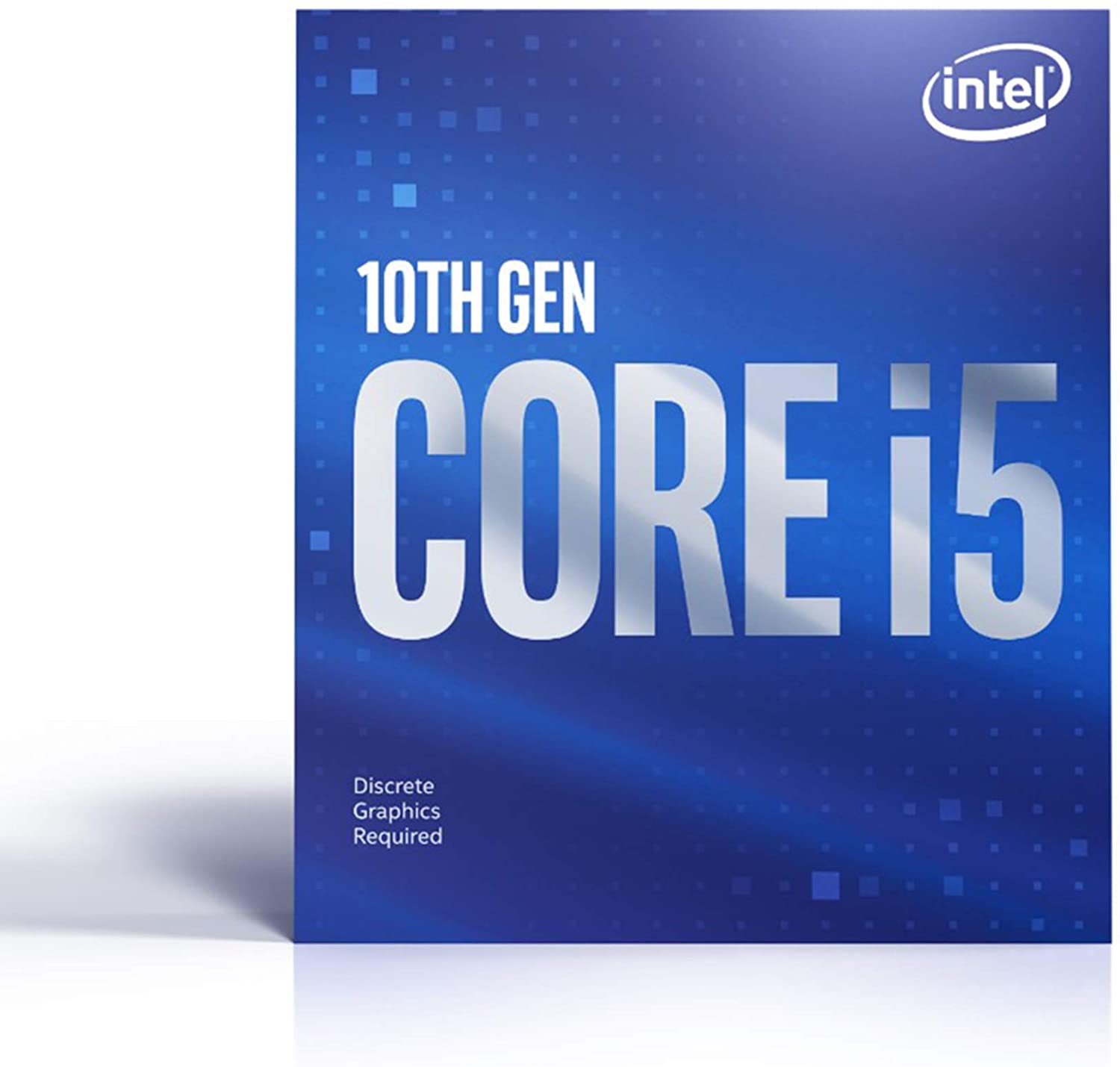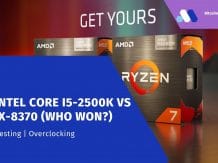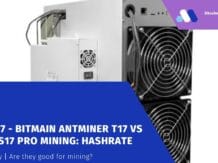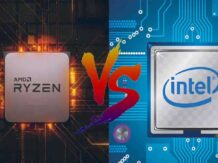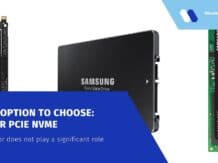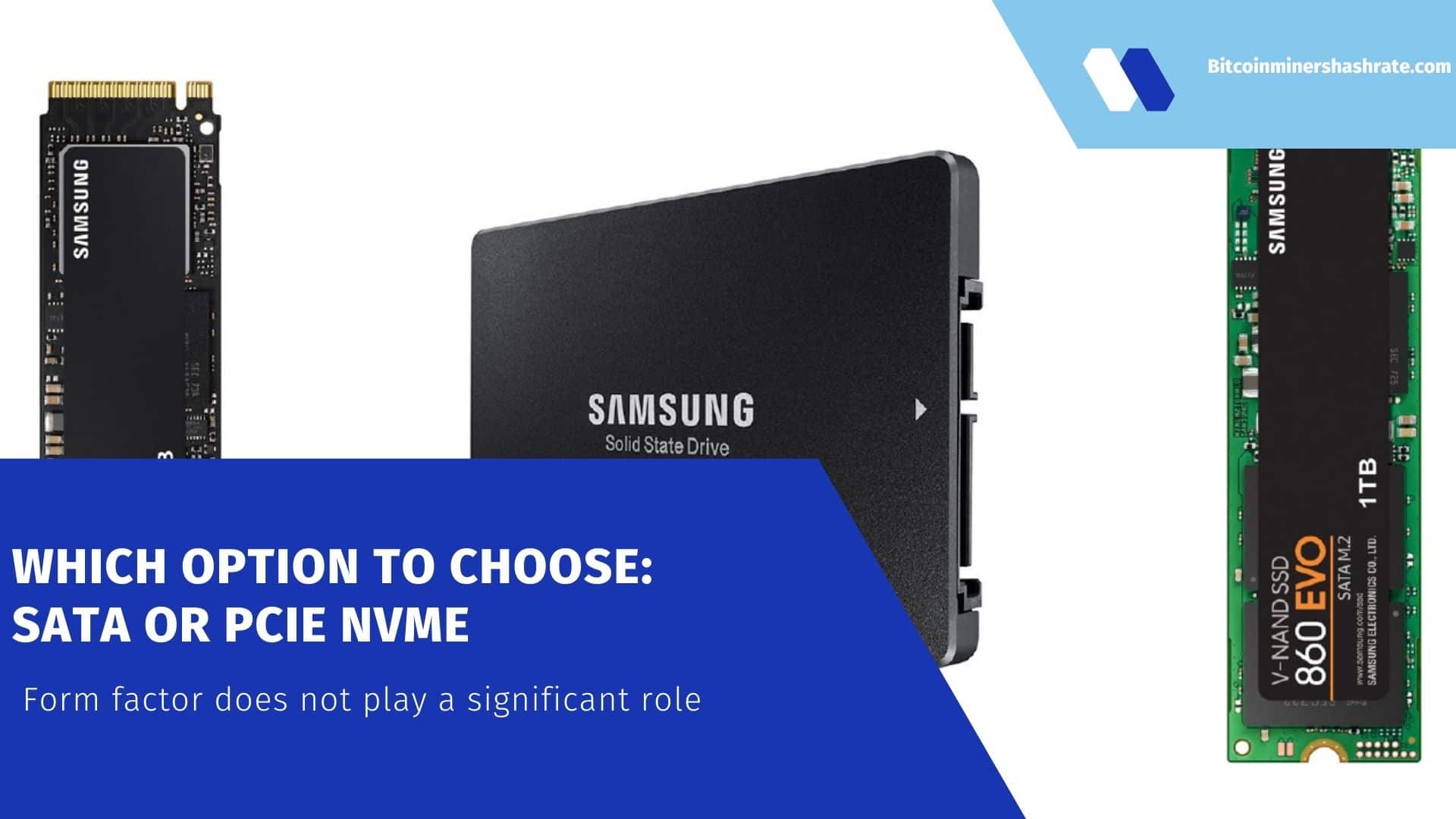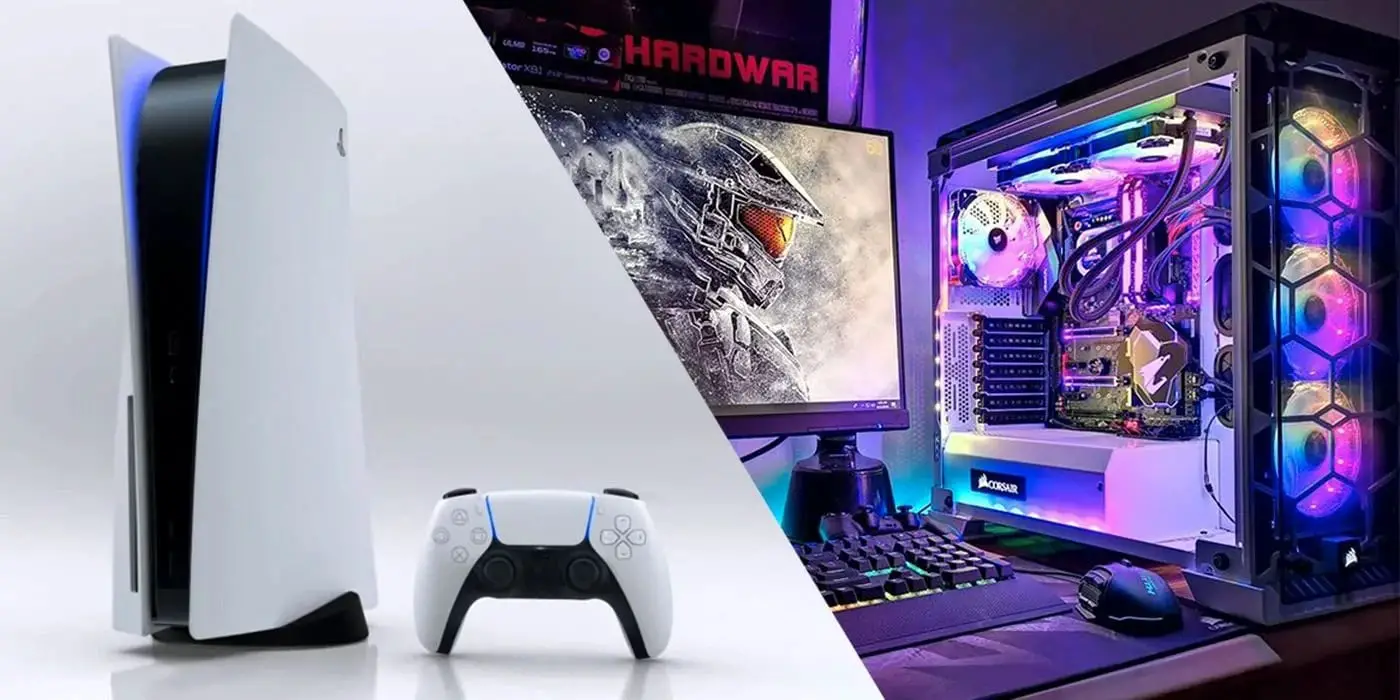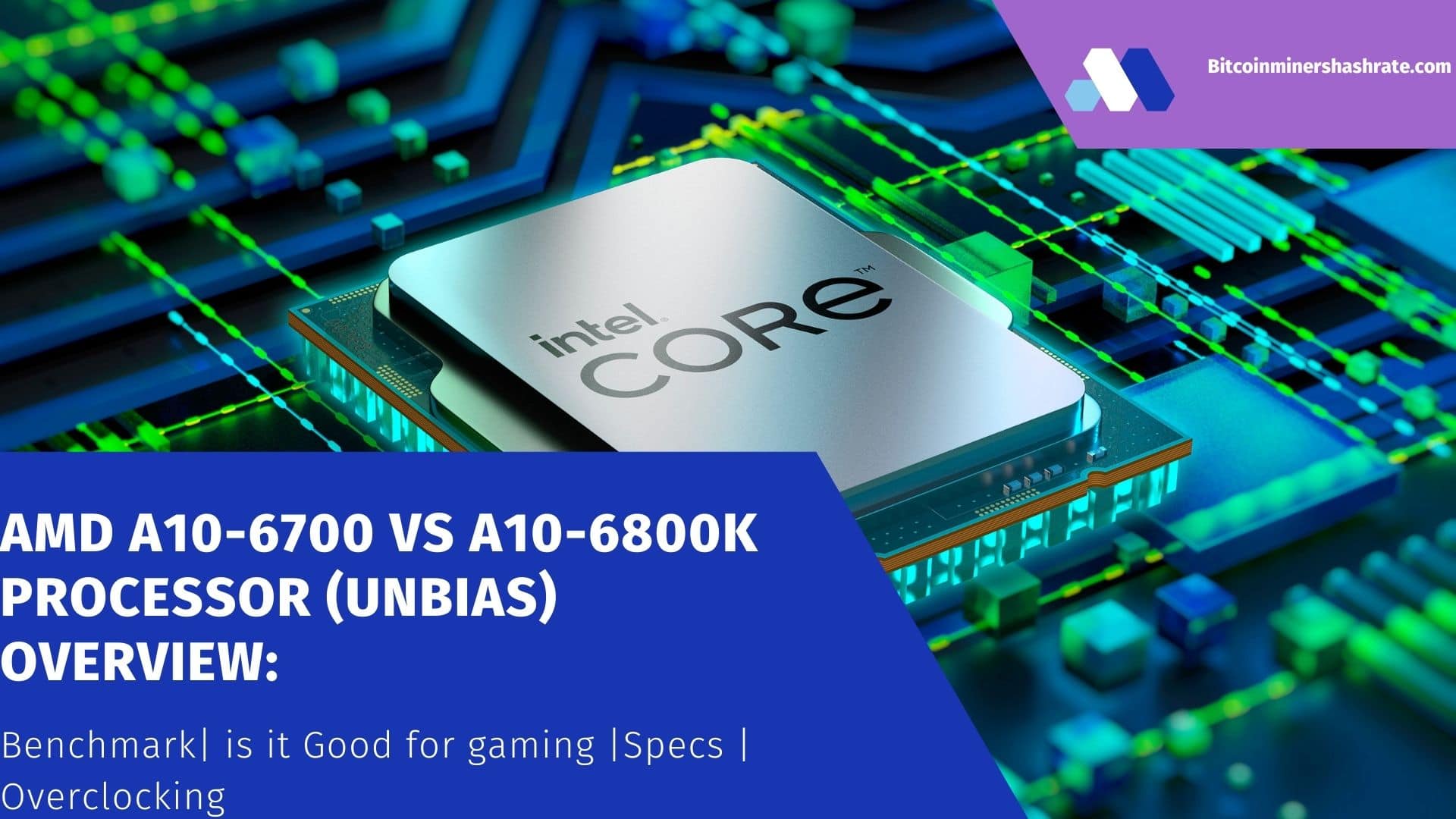Core i5-10400 Vs Core i5-10400F: Review/ Benchmark/ Which is Better ? – Core i5-10400 Vs Core i5-10400F Processor – A lot of time has passed since the release of LGA1200 Intel Comet Lake processors, during which we managed to publish several reviews of the most interesting representatives of the series. On our website you can read about:
And here’s what’s interesting. As you move down the Comet Lake lineup, a clear trend begins to be traced: the simpler and cheaper the processor, the more attractive it seems to be in modern conditions. While the older Comet Lakes turned out to be both hot and gluttonous, and their price-performance ratio did not allow them to be considered full-fledged competitors for modern representatives of the Ryzen series, in the case of the Core i5-10600K, this was far from the case. The six-core Intel has adequately performed against the background of the senior six-core proposal from AMD, clearly indicating by its example that an unambiguous conclusion about the complete superiority of processors from one manufacturer or another at the present stage cannot be made.
And apparently, the most controversial situation is now emerging in the middle price segment, where six-core Ryzen 5 and Core i5 processors are fighting for the favor of users. Therefore, immediately after getting acquainted with the senior LGA1200 six-core Intel, we decided to pay attention to another processor of the same series – the junior Core i5-10400, and in particular to its modification without integrated graphics – Core i5-10400F. They, like the Core i5-10600K, have six processing cores, and at the same time their cost is about one and a half times lower and is at the level of $ 160- $ 180. As a result, it is logical for Core i5-10400 and Core i5-10400F to oppose the hit of sales, the most popular processor on the Russian market, the six-core AMD Ryzen 5 3600. And in this material we will try to determinewhich of these alternatives – the Core i5-10400F or the Ryzen 5 3600 – is better suited today for a low-cost configuration.
It would be appropriate to remind here that the junior six-core processors are traditionally good at Intel. The six-core processor of the Coffee Lake Refresh generation – Core i5-9400 – was at one time generally considered the best mid-budget model in terms of price-performance ratio, but later AMD, having switched to the Zen 2 architecture, was able to offer a more interesting option in the form of the Ryzen 5 3600. Now the six-core family Intel has become noticeably stronger again as Hyper-Threading technology was unlocked in Comet Lake. As a result, it turned out that the Core i5-10400F and Ryzen 5 3600 are not just competitors playing the game in the same price segment, but completely identical processors in the nuclear formula, having six cores and supporting twelve threads. This means that their comparison will allow at the same time to draw a more general conclusion about
Core i5-10400F vs Core i5-10400 in detail
It should be said right off the bat that the Core i5-10400F and the Core i5-10400 are almost the same thing. These processors are identical in their characteristics, and the only difference is that the version with the letter F in the name does not have integrated graphics. And in fact, the graphics core on a semiconductor chip Core i5-10400F is present, but it is locked by hardware. Intel came up with the idea of selling F-series processors last year as a measure to counter shortages, but they have caught on in the market and are now fully fledged offerings that also allow customers to save money. For example, the Core i5-10400F costs a whopping $ 25 less than the Core i5-10400.
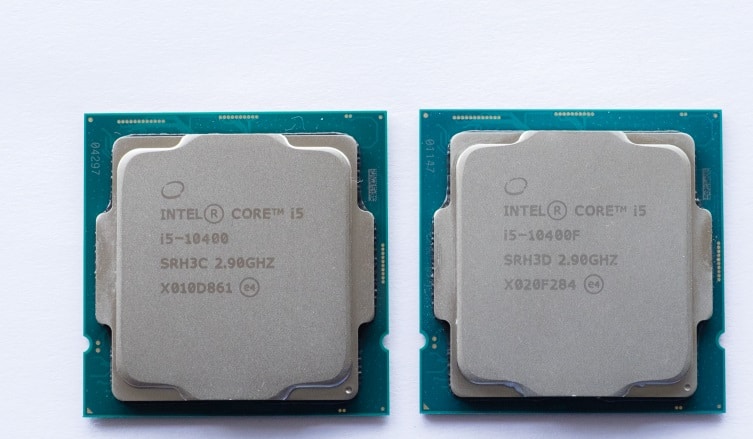
Otherwise, the Core i5-10400F and Core i5-10400 are the same. These processors have a 6/12 core formula, have 12 MB L3 cache and are designed to operate in the frequency range from the base 2.9 GHz to the maximum 4.3 GHz. Work at the upper frequency limit is provided by the traditional Turbo 2.0 technology, no new versions of Turbo Velocity Boost (auto overclocking, depending on the processor temperature) and Turbo Boost Max 3.0 (auto overclocking based on the selection of the best quality processor cores) are not supported in them. But this is not news, there are no such turbo options even in the overclocking Core i5-10600K.
| Core i5-10400 | Core i5-10400F | Core i5-9400 | Ryzen 5 3600 | |
|---|---|---|---|---|
| Announcement date | April 2020 | April 2020 | October 2018 | July 2019 |
| Platform | LGA1200 | LGA1200 | LGA1151v2 | Socket AM4 |
| Technological process, mm | 14 | 14 | 14 | 7/12 |
| Kernels / threads | 6/12 | 6/12 | 6/6 | 6/12 |
| Frequency (nominal / turbo), GHz | 2,9-4,3 | 2,9-4,3 | 2,9-4,1 | 3,6-4,2 |
| L3 cache, MB | 12 | 12 | 9 | 32 |
| TDP, Tue. | 65 | 65 | 65 | 65 |
| Memory | DDR4-2666 | DDR4-2666 | DDR4-2666 | DDR4-3200 |
| PCIe Lines | 16 × Gen3 | 16 × Gen3 | 16 × Gen3 | 20 × Gen4 |
| Integrated graphics | UHD 630 | Not | UHD 630 | Not |
| Price | $182 | $157 | $182 | $199 |
However, even despite this, the Core i5-10400 looks noticeably more attractive than the Core i5-9400 for the previous LGA1151v2 platform. The new processor not only has support for Hyper-Threading technology, which was not available before, but also increased clock speeds.
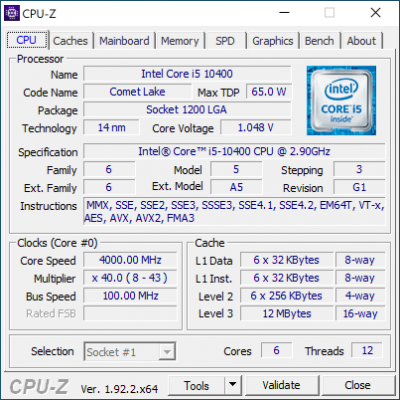 | 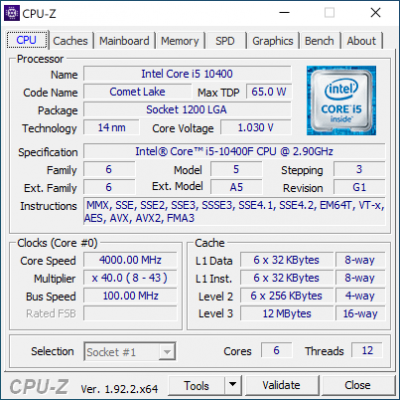 |
If you look at the frequency distribution depending on the number of working cores, it turns out that under full load, the Core i5-10400 is 100 MHz superior to the Core i5-9400, while offering twice the number of threads.
| Maximum frequency in turbo mode, GHz | Base, GHz | ||||||
| 1 core | 2 cores | 3 cores | 4 cores | 5 cores | 6 cores | ||
| Core i5-10400 | 4,3 | 4,2 | 4,1 | 4,1 | 4,0 | 4,0 | 2,9 |
| Core i5-9400 | 4,1 | 4,0 | 4,0 | 4,0 | 3,9 | 3,9 | 2,9 |
According to Intel, the processors Core i5-10400 and Core i5-10400F are available in two versions – with a semiconductor crystal stepping Q0 and G1. The difference between them is fundamental. The Q0 stepping is the same silicon found in the older Comet Lake processors. That is, these are initially ten-core crystals, in which, in the case of the Core i5-10400, four cores are hardware-locked. In fact, such processors are a rejection resulting from the production of eight- and ten-cores. However, there is an opinion that they should be emitted by low operating temperatures, resulting from both the large surface area of the semiconductor crystal, from which heat is removed, and the fact that when assembling such processors, an efficient internal thermal interface based on flux-free solder is used.
At the same time, the G1 stepping corresponds to initially six-core crystals, and in such processors Intel saves not only silicon, but also solder costs. The G1 stepping processors use a polymer internal thermal interface, that is, thermal paste.

Stepping G1 (left) and Q0 (right)
Distinguishing between Core i5-10400 and Core i5-10400F versions with different core stepping is quite simple. They not only carry different S-Spec markings, but also differ in the shape of the heat dissipation cover. G1 processors have the same lid as the previous generation Coffee Lake Refresh processors.
| Q0 (10 cores, solder) | G1 (6 cores, thermal paste) | |
| Core i5-10400 | SRH78 | SRH3C |
| Core i5-10400F | SRH79 | SRH3D |
Currently, there are G1 stepping processors on sale. It can even be assumed that the Q0 stepping has not been included in the junior six-cores at all – we do not know anything about the cases of their entering the retail sale.
This means that it is possible to buy a six-core Comet Lake with solder guaranteed only if you spend money on Core i5-10600K, which exclusively uses Q0 stepping. However, one can doubt that this is so necessary. We checked the temperature conditions of the Core i5-10400 and Core i5-10400F samples with the G1 stepping and did not find any signs of strong heating.
The graph below shows the temperatures of the Core i5-10400 and Core i5-10400F when rendering in Cinebench R20 and under load on a different number of threads and processing cores. The Noctua NH-U14S cooler was responsible for removing heat from the processors in this experiment.
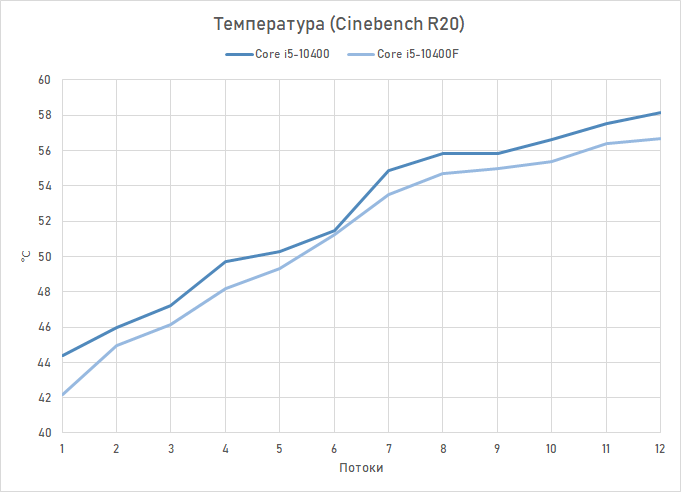
The maximum temperature of the Core i5-10400 and Core i5-10400F in this experiment was less than 60 degrees, which very clearly shows the absence of any problems with the transfer of heat from the semiconductor crystal to the heat dissipating cover of the CPU and further to the cooler, even though the speech it’s about the G1 stepping processors with thermal paste inside.
High temperatures simply have nowhere to come from. Younger six-core Intel processors differ in rather moderate power consumption and heat dissipation, so the problem of strong heating is not worth it at all. Formally, a thermal package of 65 W is declared for Core i5-10400 and Core i5-10400F, and, which is typical, this is a value that is really close to reality. The following graph shows the measured consumption of the tested processors in Cinebench R20.
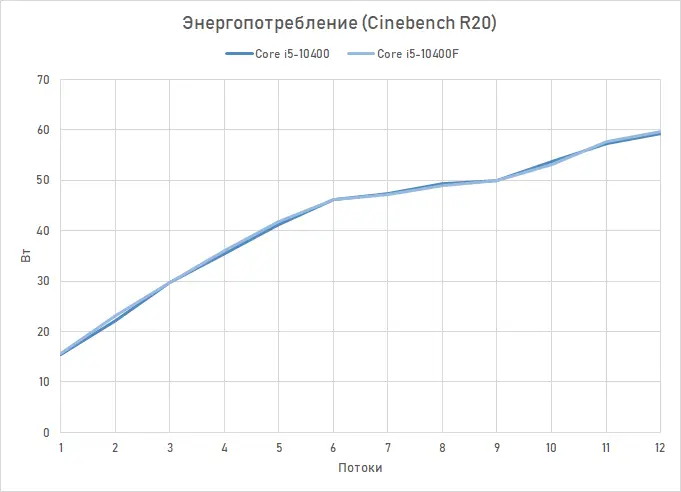
Both the Core i5-10400 and the Core i5-10400F fit well into the 65 W heat pack allocated for them, even with full load on all cores and threads. This means that even in those systems where users, for some reason, do not enable the Multi-Core Enhancements feature (which cancels the consumption limits), the frequency of the younger six-core Comet Lake will not be cut to meet the consumption limits. There is only one possible exception – heavy load using AVX2 instructions. In this case, the consumption can reach 80-85 W, but you need to keep two things in mind. First, very rare applications actually create this load. Second, the PL2 limit for the Core i5-10400 and Core i5-10400F is set to 134W, which means
Therefore, do not be surprised that the boxed cooler for the Core i5-10400 and Core i5-10400F looks like the photo below. It is quite enough.
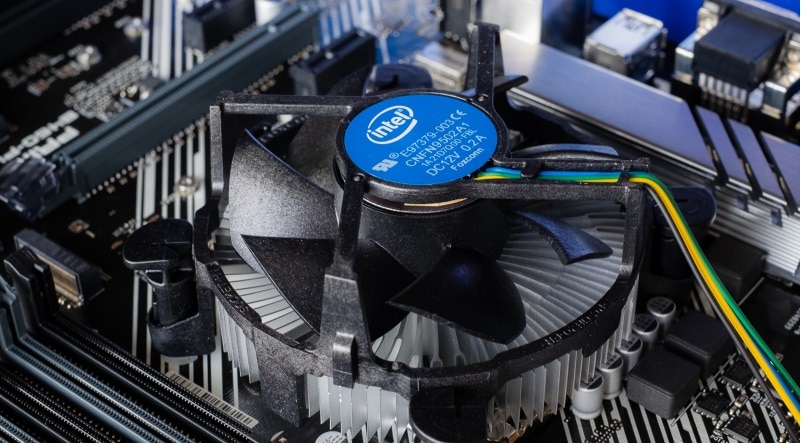
By the way, along the way I would like to draw your attention to one more point. In consumption tests, the Core i5-10400 and Core i5-10400F show almost identical results. That is, the presence or absence of a functional graphics core in the processor does not in any way affect its thermal and power characteristics, if discrete graphics are installed in the system.
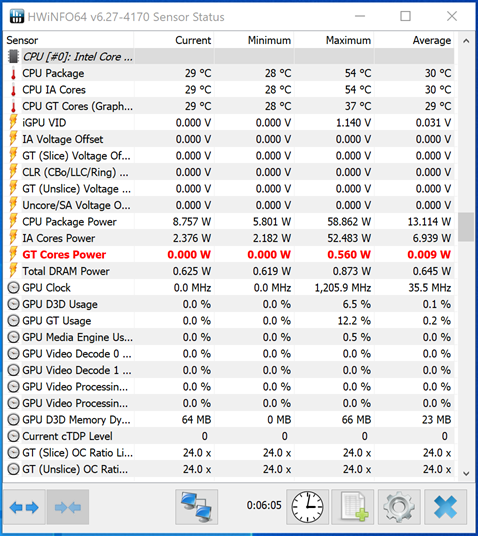
Even if the UHD Graphics 630 graphics are not disabled in the BIOS, its consumption still remains zero without real load.
⇡ # Core i5-10400F and Core i5-10400 and B460 system logic set
Talking about how good Intel processors costing $ 160- $ 180 are, it cannot be deleted from consideration the factor that they are most likely to be used in motherboards that are not based on the flagship chipset. The senior LGA1200 chipset Z490 is quite expensive, and the cost of even the most affordable motherboards based on it starts at $ 130. And this is most often too high a price for an audience focused on the acquisition of low-end six-cores.
It is much easier in systems with Core i5-10400 and Core i5-10400F to imagine motherboards on a simpler set of logic – B460. These boards cost from $ 75 to $ 150, and they seem to be a logical addition for such processors.
However, you need to understand that a system built on the Z490 and the B460 is far from the same thing. Intel actively uses to differentiate platforms by price segments, in particular, chipsets, as a result of configurations with the same processors, but different motherboards can seriously differ in both capabilities and performance. If you look at the formal specifications of chipsets for the LGA1200 platform, the situation seems to be quite transparent.
| Z490 | H470 | B460 | H410 | |
|---|---|---|---|---|
| Overclocking | There is | Not | Not | Not |
| DIMM per channel | 2 | 2 | 2 | 1 |
| Monitor outputs | 3 | 3 | 3 | 2 |
| PCIe 3.0 Lines | 24 | 20 | 16 | 6 |
| PCIe 3.0 x16 bifurcation | There is | Not | Not | Not |
| SATA III ports | 6 | 6 | 6 | 4 |
| RAID support | There is | There is | There is | Not |
| USB ports | 14 | 14 | 12 | 10 |
| USB 3.2 Gen 2 | 6 | 4 | 0 | 0 |
| USB 3.2 Gen 1 | 10 | 8 | 8 | 4 |
| Wi-Fi | Wi-Fi 6 AX200 | Wi-Fi 6 AX200 | Wi-Fi 6 AX200 | Not |
| TDP, Tue. | 6 | 6 | 6 | 6 |
According to the official specification, the B460 is devoid of overclocking capabilities compared to the Z490, does not support splitting 16 PCI Express processor lanes into two or three slots, is somewhat limited in the number of native PCI Express lanes and in the number of USB ports, and also lacks support for USB 3.2 Gen 2 …
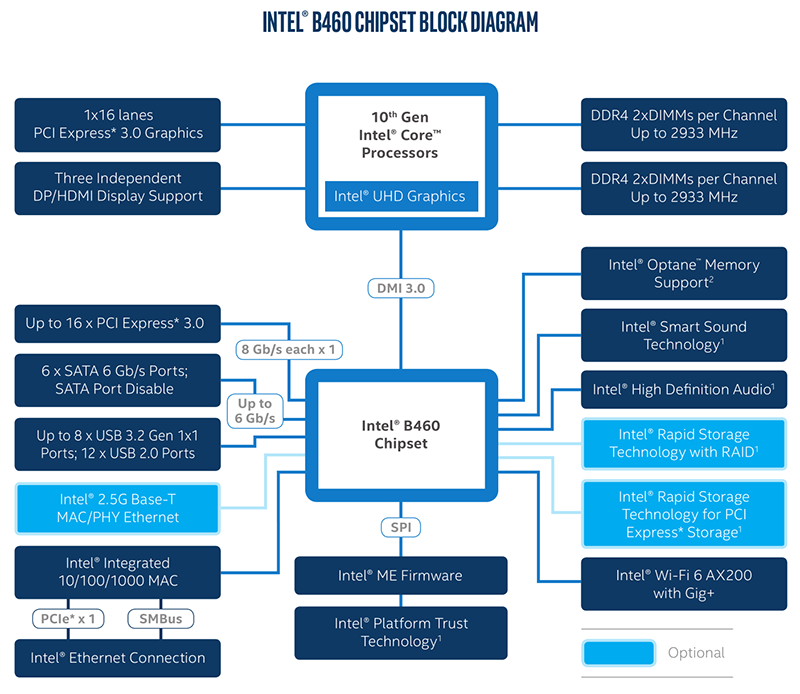
At first glance, it seems that all these losses can be easily transferred, especially if you do not plan to use a K-series processor with an unlocked multiplier with the B460-based board. Indeed, for processors like the Core i5-10400 and Core i5-10400F, the ability to manually change the multiplication factor, which is provided by motherboards on the Z490, is clearly useless – it will still not work due to the limitations inherent in the processors themselves.
In addition, the manufacturers of motherboards for their products based on the B460 have implemented various quasi-overclocking technologies that allow you to remove the consumption limits and use the processors at the maximum allowed frequency within the turbo mode. That is, motherboards based on B460 can enable Multi-Core Enhancements without any problems in the same way as more expensive platforms based on the Z490 chip do. And this is a positive point:
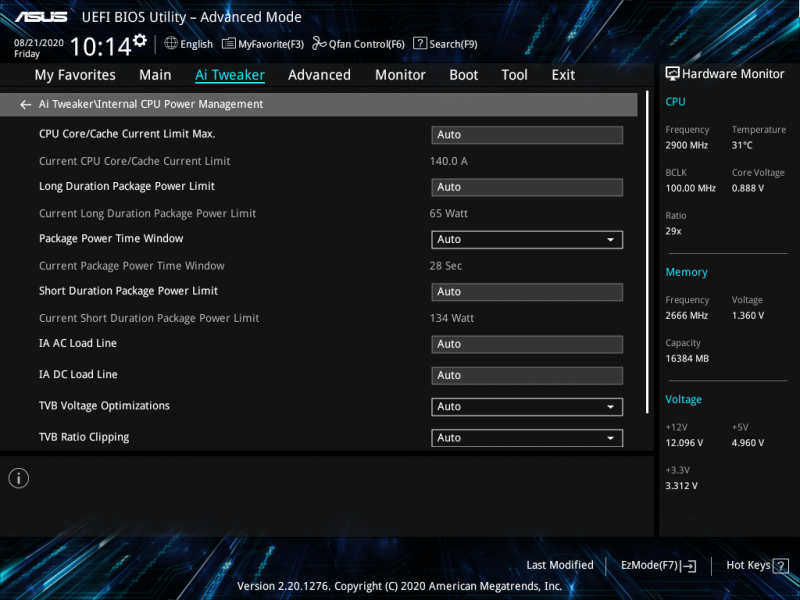
Do not worry too much about the fact that the cheapness of motherboards based on B460 turns into savings in the implementation of processor power circuits. Boards based on B460, especially those based on inexpensive ones, do have fewer phases in the power converter and often lack any decent cooling on the power elements at all. For many, this raises certain doubts about the ability of such motherboards to work without problems with six-core processors. However, if we talk specifically about the Core i5-10400 and Core i5-10400F, then such processors can work fine even in very simple motherboards. As we have seen above, their consumption in most cases fits into the 65-W frame, so you really shouldn’t worry about the fact that the VRM on the B460 board may not “pull out” the junior six-core.
As an example, we checked how the power converter on ASUS Prime B460-Plus, one of the cheapest ATX motherboards from ASUS on the B460 chipset, feels. On it, it is assembled according to the 3 + 1 formula and, moreover, is only partially covered by a radiator.
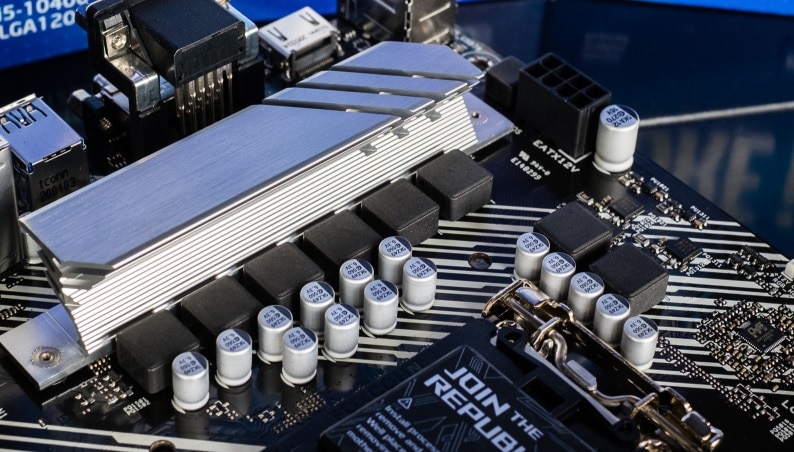
But as the experiment showed, even with a prolonged stress load in Prime95 29.8, the power circuit on this board does not overheat, and no problems with the operation of the Core i5-10400 processor arise through its fault. As follows from the thermal image below, the maximum VRM temperature under continuous load does not exceed 90 degrees. These temperatures can be considered quite acceptable, but keep in mind that the younger six-core processors with a TDP of 65 W are perhaps the most powerful processors with which cheap B460 motherboards will have no problems.
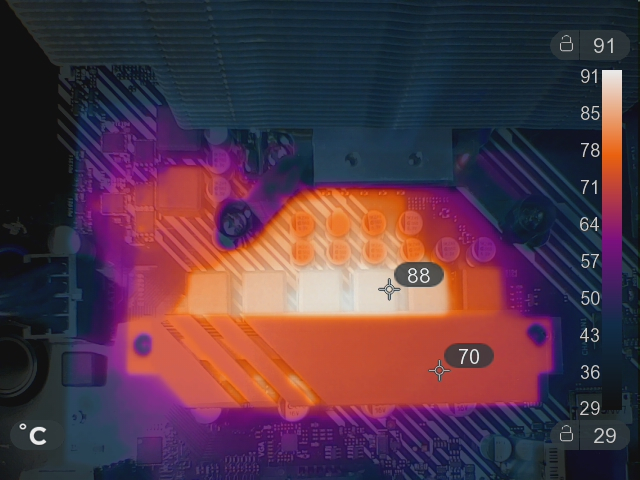
However, motherboards based on the B460 chipset still have a very sensitive flaw. The fact is that such motherboards lack support for memory frequencies that go beyond processor specifications, and this cannot be cured in any way. Thus, in B460 motherboards, the maximum supported memory mode for the Core i9 and Core i7 series processors is DDR4-2933, while the Core i5 and Core i3 processors can only work with DDR4-2666. A similar ailment was typical for previous Intel platforms, but now, unfortunately, it has spread to LGA1200 systems.
The forced limiting of the memory speed turns out to be a noticeable brake for the Core i5-10400 and Core i5-10400F, therefore, if there is such an opportunity, it is better to use these processors with motherboards based on Z490 and with fast DDR4-3200 memory or even higher frequency. This, as tests show, will allow you to get about 5-10% additional performance both in resource-intensive applications and in games. However, the price difference between motherboards based on Z490 and B460 is still too significant for most users to heed this advice. And this is a serious problem, because it turns out that junior six-cores in their natural habitat are artificially inhibited by the chipset.
If you notice an error, select it with the mouse and press CTRL + ENTER.





